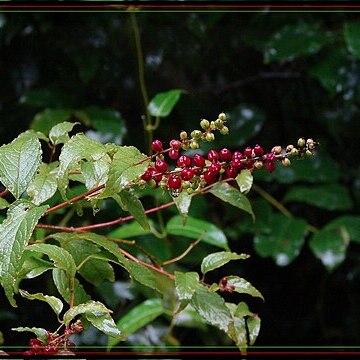Shrub, scrambling, or climber with long arching branches, sparsely to densely covered, except flowers and fruit, with simple reddish, curly hairs. Leaves alternate, entire; petiolate. Inflorescence spike-like or paniculate, terminal and axillary, one per axil. Bract sessile, erect or reflexed, persistent. Flowers bisexual or functionally unisexual (ovary or stamens present but reduced) and monoecious. Bracteoles sessile, erect, persistent. Tepals 5, free, equal, spreading in fruit. Stamens 5, fused at base into short disc; anthers bilocular; staminodes 0; pseudostaminodes 0. Ovules 2–17; style absent or single and vestigial; stigma 2–3-fid, covered in long glandular hairs. Fruit a spherical, succulent berry. Seeds 2–17, black, shiny.
Herbs erect or scandent, or clambering shrubs. Leaves alternate, petiolate. Inflorescences racemes or spikes, axillary or terminal. Flowers bisexual or unisexual; each flower with 1 bract and 2 bracteoles. Tepals 5, rarely 4, scarious, glabrous. Stamens 5, rarely 4; filaments basally connate into a cup; anthers 2-loculed. Ovary ovoid or subglobose, 1-loculed; ovules few to many; stigmas 2 or 3, rarely 4, linear or terete, united at base; pseudostaminodes absent. Berry globose, broadly ellipsoid, or obovoid, thinly walled, indehiscent. Seeds few to many, shiny black or brownish black, circular or reniform, very finely verruculose or smooth.

